Dhvaja
Dhvaja (Skt. also Dhwaja; Tibetan: རྒྱལ་མཚན, Wylie: rgyal-msthan ), meaning banner or flag, is composed of the Ashtamangala, the "eight auspicious symbols".
%2C_overlooking_Potala_White_Palace.jpg)
In Hinduism
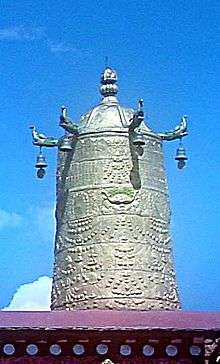
Dhvaja in Hindu or vedic tradition takes on the appearance of a high column (dhvaja-stambha) erected in front of temples. Dhvaja, meaning a flag banner, was a military standard of ancient Indian warfare. Notable flags, belonging to the Gods, are as follows:
- Garuda Dhwaja – The flag of Vishnu.
- Indra Dhwaja – The flag of Indra. Also a festival of Indra.
- Kakkai kodi – The flag of Jyestha, goddess of inauspicious things and misfortune.
- Kapi Dhwaja or Vanara dwaja (Vanara = Vana + Nara, Flag of the Man of the forest) – The flag of Arjuna in the Mahabharata, in which the Lord Hanuman himself resided.[1]
- Makaradhvaja – The flag of Kama, god of love.
- Seval Kodi – The war flag of Lord Murugan, god of war. It depicts the rooster, Krichi.
Tibetan architecture
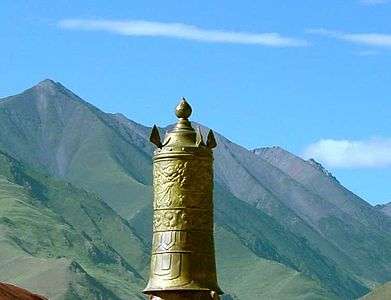
Within the Tibetan tradition a list of eleven different forms of the victory banner is given to represent eleven specific methods for overcoming "defilements" (Sanskrit: klesha). Many variations of the dhvaja's design can be seen on the roofs of Tibetan monasteries (Gompa, Vihara) to symbolyze the Buddha's victory over four maras.
In its most traditional form the victory banner is fashioned as a cylindrical ensign mounted upon a long wooden axel-pole. The top of the banner takes the form of a small white "parasol" (Sanskrit: chhatra), which is surrounded by a central "wish granting gem" (Sanskrit: cintamani). This domed parasol is rimmed by an ornate golden crest-bar or moon-crest with makara-trailed ends, from which hangs a billowing yellow or "white silk scarf'"(Sanskrit: khata) (see top right).
As a hand-held ensign the victory banner is an attribute of many deities, particularly those associated with wealth and power, such as Vaiśravaṇa, the Great Guardian King of the north. As roof-mounted ensign the victory banners are cylinders usually made of beaten copper (similar to toreutics) and are traditionally placed on the four corners of monastery and temple roofs. Those roof ornaments usually take the form of a small circular parasol surmounted by the wish-fulfilling gem, with four or eight makara heads at the parasol edge, supporting little silver bells (see the Jokhang Dhvaja on the left). A smaller victory banner fashioned on a beaten copper frame, hung with black silk, and surmounted by a flaming "trident" (Sanskrit: trishula) is also commonly displayed on roofs (see the dhvaja on the roof of the Potala Palace below).[2][3]
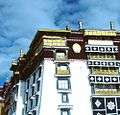 Five Dhvajas (Victory banners), on the roof of the Potala White Palace.
Five Dhvajas (Victory banners), on the roof of the Potala White Palace.%2C_roof_of_Potala_White_Palace.jpg) Dhvaja (Victory banner) - trident design with black silk, roof of the Potala Palace.
Dhvaja (Victory banner) - trident design with black silk, roof of the Potala Palace._3.0.svg.png) A Dhvaja from Jainism.
A Dhvaja from Jainism.
History
Dhvajas are probably depicted in Indus Valley Civilization seals, one Indus seal depicts four men carrying variously shaped djvajas or standards[4] and later also on cast copper coins from the early historic period of the Indian Sub continent.[5] Heliodorus pillar inscription also declares the pillar to be Garudadhvaja or Garuda standard.
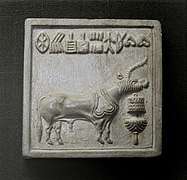 Indus seal mold depicting Dhvaja like object infront of the unicorn
Indus seal mold depicting Dhvaja like object infront of the unicorn- Jayadhvaja or triangular standard depicted on copper cast coin 1st Millennium BC
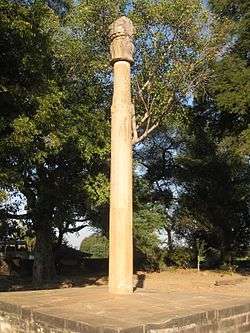 Heliodorus pillar as Garudadhvaja or Garuda standard
Heliodorus pillar as Garudadhvaja or Garuda standard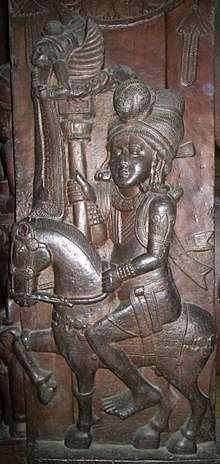 Shunga horseman carrying a portable dhvaja
Shunga horseman carrying a portable dhvaja
References
- Sri Ramakrishna Math (1985) "Hanuman Chalisa" p. 9
- A Handbook of Tibetan Buddhist Symbols by Robert Beer, Shambhala, 2003, p.13
- The Encyclopedia of Tibetan Symbols and Motifs by Robert Beer, Shambhala, 1999, p.180
- The Indian Historical Quarterly. Ramanand Vidya Bhawan. 1985.
- "NMMA". nmma.nic.in. Retrieved 2019-05-30.